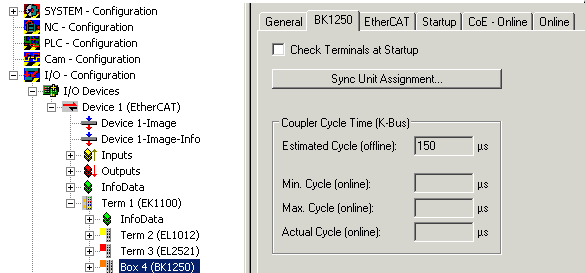EtherCAT cycle time - configuration overview
The EtherCAT cycle time with which the couplers can be operated should be considered in conjunction with the achieved K-bus cycle time. The cycle time achieved with the K-bus terminals is shown in the BK1250 tab (or BK1120 / BK1150).

If the EtherCAT cycle time exceeds the K-bus cycle time both systems operate in synchronous mode. The K-bus is started after an EtherCAT telegram and copies its inputs into the memory. They are retrieved with the next EtherCAT telegram, i.e. the inputs are always one cycle old.
If the EtherCAT cycle is shorter than the K-bus cycle, the K-bus operates asynchronous relative to EtherCAT. Faster polling than "Estimated Cycle (offline)" is therefore possible but may lead to outdated input data or outputs not being set in time via the K-bus.
The EtherCAT cycle applied to the BK1120 / BK1150 (BK1250) should therefore be significantly greater than the "Estimated Cycle (offline)" (min. 250 µs, depending on the Bus Terminal configuration). Online control in the system through "Max. Cycle (online)" or "CouplerState" is recommended.